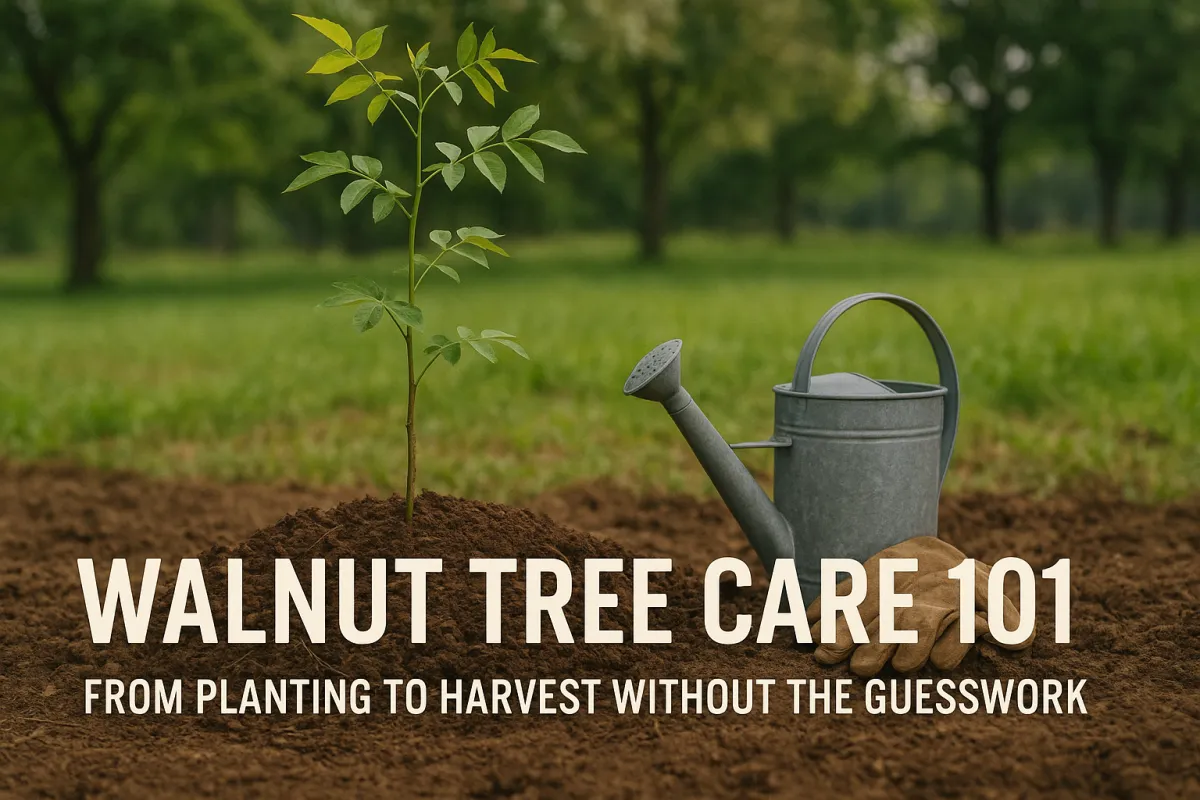
Walnut Tree Care 101
Walnut Tree Care 101: From Planting to Harvest
The Day I Planted My First Walnut Tree
I still remember the first hole I dug for a walnut tree. The shovel bounced off the hard clay more than once, and by the time the tree was in the ground, I had blisters to show for it. I watered it, mulched it, and stepped back like I had just planted a piece of my future — because I had. Years passed before I cracked the first nut from that tree, but the day I did, it felt like a victory.
If you’re thinking about planting walnuts, this guide will keep you from guessing. I’ll walk you through choosing the right variety, planting it properly, and caring for it through the years so you actually get to enjoy the nuts you worked for.
Choosing Your Walnut: English vs. Black
Not all walnuts are created equal. The two main types you’ll run across are English (Persian) walnuts and Black walnuts — and which one you choose depends on your goals.
English Walnuts:
Mild flavor, thinner shells, easier to crack
Smaller tree size (still big — plan for space)
Great for fresh eating and baking
Black Walnuts:
Bold, earthy flavor, very hard shells
Large, spreading tree — can hit 70–80 feet tall
Excellent for wood value and wildlife habitat
Avoid This Mistake: Don’t plant walnuts too close to your garden beds. Walnuts produce juglone, a natural chemical that can stunt or kill tomatoes, peppers, and many other plants. Give your vegetables plenty of space — 50 feet minimum.
Site Selection and Planting
Find the Right Spot
Walnuts love full sun — at least 6–8 hours a day — and they won’t tolerate wet feet. Choose a well-drained site and avoid low spots where water pools. Aim for loamy soil with a pH between 6.0–7.5.
Planting Depth & Spacing
Whether you’re planting a bare-root or container-grown tree, make sure the root flare sits just above soil level. This prevents rot and encourages proper root growth.
Spacing:
English walnuts: at least 35–40 feet apart
Black walnuts: 50–60 feet apart — these giants need room to spread
Grandma’s Tip
“Plant it where you can see it from the kitchen window. A walnut tree is a friend for decades — keep it close enough to enjoy.”
Seasonal Care: The Early Years
Watering Young Trees
For the first two years, keep your tree watered deeply once a week, especially in hot, dry weather. Think slow soak, not daily sprinkle — you want those roots to chase the water down deep. After year three, your tree should handle most of its water needs on its own.
Mulching & Weed Control
Mulch helps young walnut trees thrive by holding moisture and suppressing weeds. Spread a 3–4 inch layer of wood chips or shredded bark in a wide circle around the tree — but keep it pulled back from the trunk.
Pro Tip: Don’t pile mulch against the trunk. It traps moisture, invites rot, and can even kill the tree.
Fertility & Growth
Walnuts grow steadily if you feed them right. Apply a balanced fertilizer (like 10-10-10) in early spring before leaf-out, but skip the heavy hand — too much nitrogen can delay nut production.
Do a soil test every 2–3 years to monitor pH and nutrient levels. Correct imbalances with lime or compost before they become problems.
Long-Term Maintenance
Pruning
Shape your walnut tree early. In the first 3–5 years, select strong scaffold branches and remove competing leaders. Once mature, prune only to remove dead or crossing branches — heavy pruning can stress nut production.
Pest & Disease Watch
Common threats include:
Walnut husk fly: causes husk damage — pick up and destroy dropped nuts
Thousand cankers disease: look for yellowing leaves and cankers on branches — remove infected limbs early
Encouraging Nut Production
Most walnut trees take 5–8 years to produce nuts, and production ramps up after year 10. Plant at least two trees if possible — better pollination means bigger yields.
Harvest & Storage
You’ll know walnuts are ready when their green husks begin to split. Gather promptly to keep quality high. Remove husks, wash nuts, and dry them in a single layer for 2–3 weeks in a well-ventilated space before cracking or storing.
Faith Touch
“Build houses and dwell in them; plant gardens and eat their fruit.” — Jeremiah 29:5
Planting a walnut tree is an act of faith. You may not see its full yield for years, but your children — or the next family who owns your land — will.
Closing + Call to Action
Walnut trees demand patience, but they’ll reward you with shade, beauty, and bushels of nuts for decades.
📥 Download the free Walnut Tree Planting & Care Calendar to stay on track from year one through your first harvest.
Tell me in the comments — where are you planting your walnut tree? Near the house? On the back fencerow? I’d love to hear your plan.


Facebook
Instagram
X
Youtube